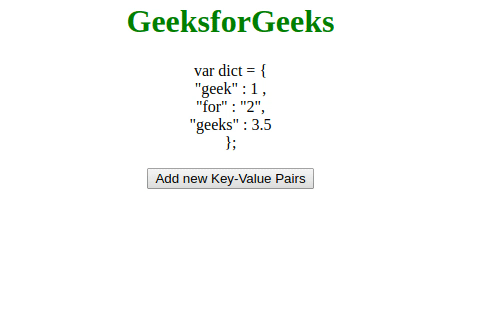How to create dictionary and add key–value pairs dynamically?
Last Updated :
28 May, 2020
In this article, we will discuss how we can create a dictionary in JavaScript and add key-value pairs in it. Actually there is no ‘dictionary’ type in JavaScript but we can create key-value pairs by using JavaScript Objects. Create a new JavaScript Object which will act as dictionary.
Syntax: Key can be a string , integer. If you just write key1 or any number, it will treat as a string.
var dict = { key1 : value1 ,
key2 : value2 ,
....
};
- Create empty dictionary
var dict = {};
- Adding Key-Value Pairs in Dictionary
dict[new_key] = new_value;
or
If new_key is already present in the dictionary then the value of this will be updated to new_value.
dict.new_key = new_value;
- Accessing Key-Value Pairs
var value = dict[key];
or
var value = dict.key;
- Iterating the whole dictionary
for(var key in dict) {
console.log(key + " : " + dict[key]);
}
Example:
HTML
<!DOCTYPE html>
<html>
<head>
<title>Dictionary in Javascript</title>
</head>
<body style="text-align: center;">
<h1 style="color: green;">
GeeksforGeeks
</h1>
<p>
var dict = { <br />
"geek" : 1 , <br />
"for" : "2", <br />
"geeks" : 3.5 <br />
}; <br />
</p>
<button onClick="fun()">
Add new Key-Value Pairs
</button>
<p id="demo"></p>
<script>
function fun() {
var dict = {
geek: 1,
for: "2",
geeks: 3.5,
};
dict.new_geeks = "new_value";
dict["another_new_geeks"] =
"another_value";
var to_show = "var dict = { <br>";
for (var key in dict) {
to_show += '"' + key + '" : '
+ dict[key] + "<br>";
}
to_show += " }; <br>";
document.getElementById("demo")
.innerHTML = to_show;
}
</script>
</body>
</html>
|
Output:

Share your thoughts in the comments
Please Login to comment...